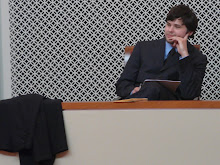I have decided to go back through the entire SSMC (Schillinger System of Musical Composition) and the MBA (Mathematical Basis of the Arts) and take detailed notes. I have also decided that I will put all of these notes here on my blog for all the world (or maybe like one person) to see and and maybe gain a better understanding of what I believe to be such an important work.
I don't want to say that I am dome sort of Schillinger groupie or anything but I believe that his works are truly of merit. They were not just a collection of rules set down some two-hundred years ago, nor were they applicable only to the "twentieth century" style either. People like him and Howard Hanson (whom I will have more on later) have interesting and important, allbeit somewhat radical, views on music.
I realize that I alone am not going to bring ideas like this back to the mainstream or really change anything in anyway, but most of the information you can find about theories like these are mainly just overviews or come from very expensive online teachers and courses. All I am trying to do is provide a place, where if someone is interested in what I have to offer they can get it for free.
Stay tuned as I go back through all twenty-two hundred pages of Schillinger's works that I own, it should me fun.
Geolocate this post
Posted with LifeCast
7.19.2008
7.18.2008
Here It Goes.
So I am finishing what looks to be the last of my works that will rely heavily on the major/minor system. It is a string quartet (my first) in three movements, written especially for my upcoming wedding. It is basically program music:
1. Music for before the ceremony
2. The bridal march
3. Exit music
So it is pretty basic as far as structure and tonal applications go, after all it is music to fill a particular context, in this case a wedding, so I really didn't feel comfortable going to far away from standard practice.
Here is a short overview:
Movement number one follows, more or less, the traditional sonata-allegro form (I don't want to go into to much detail, I am really paranoid about people taking my ideas, I will post more extensive examples and explanations after the performance and copyright).
The bridal march is actually a three-part mensuration canon, with a fourth free voice added, and a touch of modality.
The final movement is a short rondo, with an Irish flair.
1. Music for before the ceremony
2. The bridal march
3. Exit music
So it is pretty basic as far as structure and tonal applications go, after all it is music to fill a particular context, in this case a wedding, so I really didn't feel comfortable going to far away from standard practice.
Here is a short overview:
Movement number one follows, more or less, the traditional sonata-allegro form (I don't want to go into to much detail, I am really paranoid about people taking my ideas, I will post more extensive examples and explanations after the performance and copyright).
The bridal march is actually a three-part mensuration canon, with a fourth free voice added, and a touch of modality.
The final movement is a short rondo, with an Irish flair.
So far the hardest part of the whole process for me is the fact that I am trying to stay within a major tonality, because I didn't think anything deliberately "minor-sounding" stayed within the vein of wedding music.
More to come as it progresses.
7.14.2008
So It Begins.
I have reached the conclusion that the tyranny of the major/minor system of tonality has gone on for too long.
Wow that sounded preachy.
Any way, I have decided not to hinder myself with the "laws" of traditional western music. It just doesn't make sense to me. Why for the past two hundred years have basically two scales been the basis for music? If you look at other countries, India (southern), for example have a system of seventy-two parent scales. A lot of them have the same basic structure of our major (whole whole half whole whole whole half) but with the intervals permuted. (I'll show examples later I just don't have my books with me right now).
So I just finished reading the Schillinger System of Musical Composition and the Mathematical Basis of the Arts by Joseph Schillinger and I thought they were amazing. They opened up a lot of doors for me, so they will probably be influencing the things I write from now on, so if anyone does read this they will learn a little more about his ideas as well.
Geolocate this post
Posted with LifeCast
Wow that sounded preachy.
Any way, I have decided not to hinder myself with the "laws" of traditional western music. It just doesn't make sense to me. Why for the past two hundred years have basically two scales been the basis for music? If you look at other countries, India (southern), for example have a system of seventy-two parent scales. A lot of them have the same basic structure of our major (whole whole half whole whole whole half) but with the intervals permuted. (I'll show examples later I just don't have my books with me right now).
So I just finished reading the Schillinger System of Musical Composition and the Mathematical Basis of the Arts by Joseph Schillinger and I thought they were amazing. They opened up a lot of doors for me, so they will probably be influencing the things I write from now on, so if anyone does read this they will learn a little more about his ideas as well.
Geolocate this post
Posted with LifeCast
Subscribe to:
Comments (Atom)

